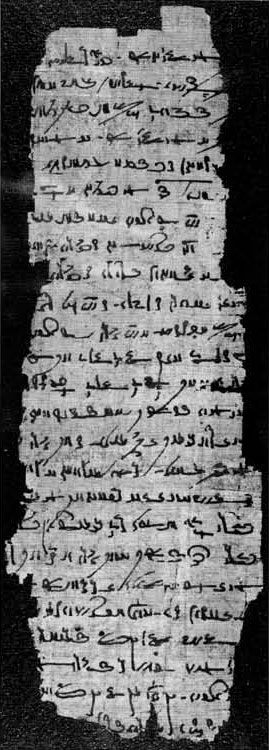
One of the oldest types of ancient Egyptian literature is that known as “instructions” or “wisdom literature”. “Instructions” appeared in the Old Kingdom (2625-2130 BC) and continued to be written for over 2000 years. Usually taking the form of a father addressing his son, these instructions provided an ancient audience with moral and ethical guidelines for living.
One of the most important Egyptian instructions is Papyrus Insinger. ( The ancient Egyptians wrote on a paper like material called papyrus made from the Nile plant of the same name.) Dating to the 1st century AD, Papyrus Insinger contains over 800 maxims organized into single-line sentences grouped into numbered chapters. Originally the text consisted of 25 chapters. In 1895, J.H. Insinger acquired most of the papyrus from a dealer in Cairo for the Rijksmuseum in Leiden. The first five chapters had previously been separated and sold to different collectors and their content was unknown.
In 1910 Max Muller wrote from Cairo to George Byron Gordon, the Director of the University Museum, asking for permission to purchase objects for the Museum. He mentions, “so far I have not found anything extraordinary among the things in the market. But there is one great bargain which I hate to let go… a good sized box of papyrus.” Muller pleaded with Dr. Gordon to send him a check to purchase the documents. His pleas must have been successful on the next communication is a receipt for papyri dated October 31, 1910.
It was not until the late 1970’s that the identity of the pieces in Philadelphia was discovered. At that time, Prof. Karl-Theodor Zaurich discovered that two of the fragments contained sections of Papyrus Insinger. Incredibly, these two fragments proved to be part of the missing chapters from the beginning of the text that had been lost for nearly a century.
Many of the maxims in Papyrus Insinger reflect a belief in fate’s role in everyday life. Our fragments include lines such as “God is the one who causes fortune; the wise man (is) the one who causes savings” and “Surplus increases for its possessor because of good fortune” (in fragment pictured). By studying these newly identified pieces, we can bring together a remarkable text that has been separated for over 100 years. A complete translation, analysis, and discussion of these missing fragments will appear as part of my dissertation on Demotic Wisdom Literature.
